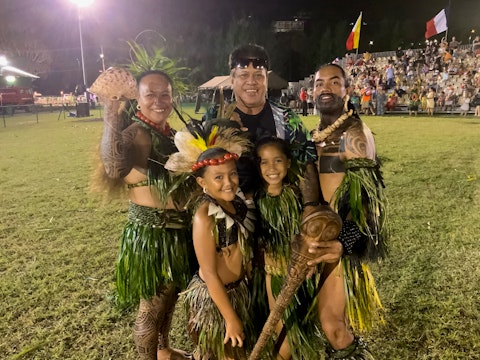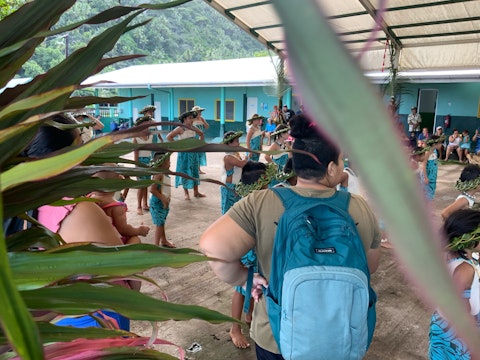Building a Future on the Past
In the open-air kitchen belonging to my adoptive ènata (Marquesan) family in Vaitahu, Tahuata, I sit at the battered wooden table with my ènata father, Manuhi Timau
In the open-air kitchen belonging to my adoptive ènata (Marquesan) family in Vaitahu, Tahuata, I sit at the battered wooden table with my ènata father, Manuhi Timau
I am eating a breakfast of hard crackers and instant coffee; Manuhi, a fisherman, rises early and likely ate his meal hours ago. The news report from France blares from the television on the side porch, and out in the yard one of the dogs raises its head at a passing pickup truck. A soft breeze tinged with the smell of smoke drifts in from the valley side of the house, and a cat hops up onto the bench beside me.
We are discussing Te Tuhuna Èo Ènata (the Marquesan Academy), an organization dedicated to preserving and reinvigorating ènata language. Manuhi adjusts his reading glasses and shares a concern I have often heard from ènata. “The Academy must not make up new words because they have no basis in truth,” he says. “They aren’t real. The real words come from this or that island, and mixing them or using them to make a new word means they have no meaning any more. They have no roots.”
For the inhabitants of Fenua Ènata (also known as the Marquesas Islands), roots are a big deal. As these inhabitants of a tiny island chain navigate what they call “modernity,” they draw heavily upon a unique ènata language, cuisine, artistic traditions and customary practices. In the process, they often turn to the past to learn “real” ènata words, dances, chants and artistic motifs. They consult their elders and pour over historic accounts of island life. Some are actively working to develop adventure tourism around a particular “authentic” vision of traditional culture based on historical perceptions. But what about ènata’s future?
Three of Manuhi’s children have approached this question in different ways. One became a carver and a carpenter. Another was trained as an electrician and became a fisherman, though he still dreams of learning to carve (“my one regret is that I never really learned the culture, carving and all that,” he said in 2023). A third got an advanced arts degree from the Center of Artistic Crafts in Tahiti and continues to make jewelry when she isn’t working at her mother-in-law’s snack bar. Each is perpetuating ènata culture in their own way, pursuing a livelihood while also striving to hold onto their roots.
Te Tuhuna Èo Ènata is doing the same, in its own way, by working to modernize ènata language. Drawing on the knowledge of elders and 19th century lexicons of the old language, they are crafting new ènata words for things such as smartphones and the internet. They are grappling first-hand with what it means to be ènata today. Yet, for many ènata, building a future is not simply a matter of embracing modernity with traditional tools. Whether carving traditional motifs, hunting crabs on the rocky shore, or speaking everyday Marquesan (as opposed to the Academy’s more official version) with their children, ènata celebrate the lives and expertise of their ancestors in diverse and subtle ways. In their daily lives they use specific knowledge and practices acquired from those who came before them: their parents, grandparents and other elders. And in so doing, they perpetuate ènata traditions of all kinds, “traditional” or not, and craft their own uniquely ènata future.
As a foreign anthropologist looking in, I hope ènata will increasingly recognize different forms of cultural continuity as they move forward, by embracing not only the most obvious kinds of historical roots but also those anchored in relationships to family and community, land and sea.





